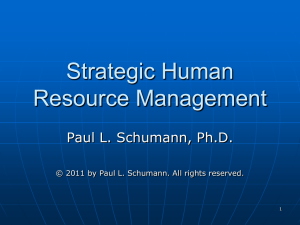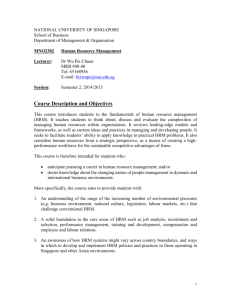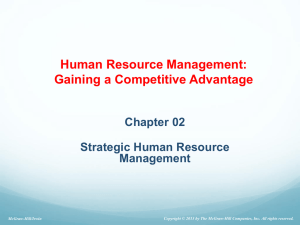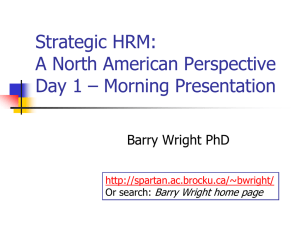INTRODUCING HUMAN RESOURCE MANAGEMENT
advertisement
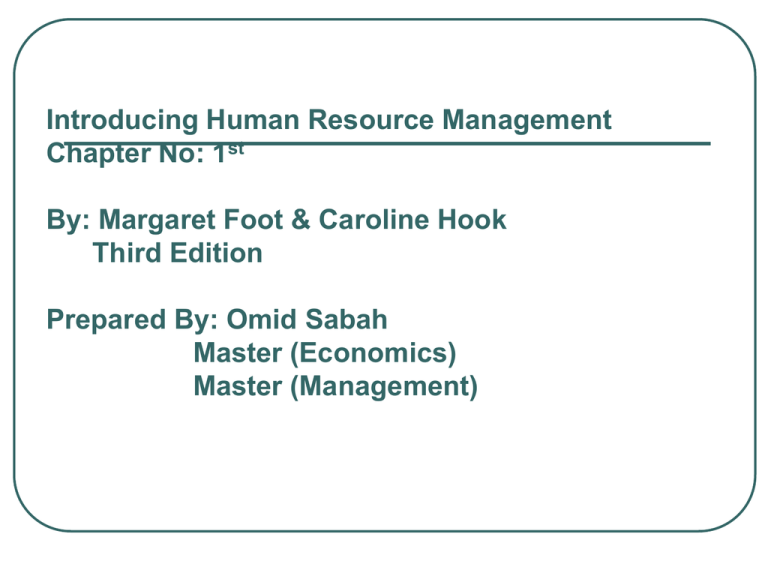
Introducing Human Resource Management Chapter No: 1st By: Margaret Foot & Caroline Hook Third Edition Prepared By: Omid Sabah Master (Economics) Master (Management) Introducing Human Resource Management Objectives By the end of this chapter you will be able to: What is HRM? Why we are concerned with HRM? What is meant by the terms personnel management? Shifting from personnel management to HRM Concept of People working as individual, Group, and Team What is Human Resource Management? Managerial function that tries to match an organizations needs to the skills and abilities of its employees OR Managing the people in organization is called HRM OR Concerned with attracting, maintaining and developing people in organization Human Resource Management Resource Human HRM Management Why We are Concerned with HRM? Today if you are running a project what source do we need more to be successful? Arrangement of Technology? Arrangement of Budget? Arrangement of Land? Arrangement of People? Human resource arrangement is a big deal for any type of business success What is Meant by Personnel Management? Is the study of how employers obtain, develop, utilize, maintain, the right number of persons for the right work or job Primary Activities of Personnel Management Planning company picnics or to arrange some parties of fun programs for the department Scheduling Vacation Example: Who should leave for holiday this month? Enrolling workers for health-care coverage Planning retirement parties Shifting from Personnel management to HRM (History) Personnel management has been a recognized function in the USA since 1890s Management thinking was developed until 1950s Human Relations can effect productivity In 1970, the job of HR manager was to keep their companies out of court From the 1970s onwards, change was the primary concern Because all of the mentioned changes in personnel management the concept of HRM was emerged in 1990 and 20th s Organizations changed with Time What was the primary concern of organizations at that time (Century ago)? Before 1900, there main concern was producing more and more, to bring more people in production place 1900-10, Employee Welfare: At this time organization was a little thinking that employee need something to eat and give some reward 1930-40, Unionization and productivity: with union there was great productivity 1940-50, Economic Security: The more economic resources you have the more you were secured 1950-60, Human Relations can direct effect the production 1960-70, Employment Law: Rule and regulation about employment should be strong 1970-80, Quality of Work Life (QWL): Working in safe environment where stress is less Example: If you have good computer with air-conditioned and good furniture off course you will be more energetic and motivated Organizations changed with Time (Continued) 1980-1990, Employee Displacement: New technologies were introduced, people were differentiating that this worker is good and this is not, ten persons work can be done by five persons 1990-2000, The main concern was productivity, efficiency, and quality 2000, how to survive from competitive pressures Shifting from personnel management to HRM 1940’s-1950’s 1960’s-1970’s 1980’s 1990’s 2000’s Mechanistic Period Legalistic Period Organistic Period Strategic Period Catalytic Period Mechanistic Period (1940-50): Manufacturing was the driver of industry and the HR was performed in mechanical way Shifting from personnel management to HRM (Continued) Legalistic Period (1960-70): Rules and regulations were made to control the employee through this Organistic Period (1980): To bring change in work environment because to make organization profit oriented Strategic Period (1990): HR becomes a truly strategic function Catalytic Period (2000): To speed up the reaction Example: Today new trends are entering the organizations but HR is playing a key role in that Concept of people working as Individuals, Groups and Teams Individual: Those who wish to work individually in organization want pride and need recognition Group: A group is just a collection of people with something in common Why do People Join Group? Because of the following reasons: Security: In organization and society getting more people get together with each other means secure Status: Every person is feeling pride that other people should give him/her respect Social Need: Every person inside society wants to communicate and participate Power: Alone if you are talking no one will lesson but as a group every one can pay attention Goal Achievement: Achieving something alone can not be productive than achieving in group Types of Groups Formal Groups: Gathering of people and assign them work from organization side Informal Groups: People from different minds, attitudes close together and they form a group Teams? The word team stands for? T=? E= ? A= ? M= ? “Its easy to get players, Getting them to play together, that the hard part” A team is internally organized, with specific goals and usually with specific roles for different members of the team Types of Teams Following are some essential types of team: Problem Solving Team: This team is form because to solve specific problem Self-Managed Team: Team which is able to manage their self various types of condition Cross-Functional Team: Different members of departments are getting together to solve the problem Virtual Team: Communication between a team in various different locations Example: one member of team is in Kabul another in USA, all they should communicate with each other How to bring Individuals into Teams? Following are the effective ways: Selection: Here selection means picking the right person for the job Training: By picking the person only is not enough but to train and develop them Rewards: When he or she shows excellent efforts a reward should be given to him or her Key Differences between Teams and Groups Team: team building can take years Group: group building can take a few minutes Team: team is more difficult to form because members of team may be selected from there skill, experience Group: group is much easy to form Example: If you had a room filled with professional accountants, for example, they can be grouped according to gender, age, and other common factors Key Differences between Teams and Groups (Continued) In a group, members think they are grouped together for administrative purposes only. In a team, members recognized their dependence and understand both personal and team goals are best accomplished with mutual support. Key Differences between Teams and Groups (Continued) In a group, members tend to focus on themselves because they are not sufficiently involved in planning the unit's objectives. In a team, members feel a sense of ownership for their jobs and unit, because they are committed to values based common goals which they helped establish. THE END OF CHAPTER ST NO: 1 INTRODUCING HUMAN RESOURCE MANAGEMENT THANKS






